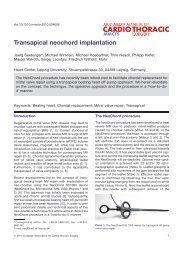The surgical anatomy of the aortic root - Multimedia Manual Cardio ...
The surgical anatomy of the aortic root - Multimedia Manual Cardio ...
The surgical anatomy of the aortic root - Multimedia Manual Cardio ...
You also want an ePaper? Increase the reach of your titles
YUMPU automatically turns print PDFs into web optimized ePapers that Google loves.
R.H. Anderson / <strong>Multimedia</strong> <strong>Manual</strong> <strong>of</strong> <strong>Cardio</strong>thoracic Surgery / doi:10.1510/mmcts.2006.002527<br />
Photo 8. This dissection has been made first by removing <strong>the</strong> freestanding<br />
subpulmonary infundibulum, and <strong>the</strong>n by removing <strong>the</strong> triangle<br />
between <strong>the</strong> two coronary <strong>aortic</strong> sinuses. As can be seen,<br />
<strong>the</strong> tip <strong>of</strong> <strong>the</strong> triangle ‘points’ to <strong>the</strong> tissue plane between <strong>the</strong> back<br />
<strong>of</strong> <strong>the</strong> infundibulum and <strong>the</strong> <strong>aortic</strong> <strong>root</strong>.<br />
valvar components. <strong>The</strong> supravalvar components, <strong>the</strong><br />
<strong>aortic</strong> sinuses, are primarily <strong>aortic</strong> in structure, but<br />
contain structures <strong>of</strong> ventricular origin at <strong>the</strong>ir base.<br />
<strong>The</strong> supporting subvalvar parts are primarily ventricular,<br />
but extend as thin-walled fibrous triangles to <strong>the</strong><br />
level <strong>of</strong> <strong>the</strong> sinutubular junction. <strong>The</strong> sinutubular junction<br />
itself forms <strong>the</strong> discrete distal boundary <strong>of</strong> <strong>the</strong><br />
<strong>root</strong>. <strong>The</strong> valvar leaflets are attached peripherally at<br />
this level, and hence, <strong>the</strong> junction is an integral part<br />
<strong>of</strong> <strong>the</strong> valvar mechanism. Any significant dilation at <strong>the</strong><br />
level <strong>of</strong> <strong>the</strong> sinutubular junction will produce valvar<br />
incompetence. It is moot, <strong>the</strong>refore, whe<strong>the</strong>r stenosis<br />
at this level should be labelled as ‘supra<strong>aortic</strong>’, since<br />
<strong>the</strong> sinutubular junction is just as crucial a component<br />
<strong>of</strong> <strong>the</strong> overall valvar mechanism as are <strong>the</strong> leaflets and<br />
<strong>the</strong>ir supporting sinuses w8x. Anatomically, <strong>the</strong> sinutubular<br />
junction is no more than <strong>the</strong> distal extent <strong>of</strong><br />
<strong>the</strong> overall valvar complex.<br />
Is <strong>the</strong>re a valvar annulus?<br />
<strong>The</strong> answer to this question, <strong>the</strong> major ongoing<br />
conundrum for <strong>the</strong> cardiac surgeon, depends very<br />
much on <strong>the</strong> structure nominated to represent <strong>the</strong><br />
‘annulus’. If we take refuge in <strong>the</strong> dictionary, and seek<br />
etymological origins, <strong>the</strong>n we find that an annulus is<br />
no more than a little ring. In this regard, it is certainly<br />
<strong>the</strong> case that <strong>the</strong> entirety <strong>of</strong> <strong>the</strong> <strong>aortic</strong> <strong>root</strong> can be<br />
removed from <strong>the</strong> heart, and can be slipped on <strong>the</strong><br />
finger in <strong>the</strong> form <strong>of</strong> a ring. As far as I am aware,<br />
however, no surgeon defines <strong>the</strong> entirety <strong>of</strong> <strong>the</strong> <strong>root</strong><br />
as <strong>the</strong> <strong>aortic</strong> valvar annulus. Most surgeons seem to<br />
nominate <strong>the</strong> remnants <strong>of</strong> <strong>the</strong> removed valvar leaflets<br />
as <strong>the</strong>ir annulus w3, 9x. As I have described, however,<br />
by virtue <strong>of</strong> <strong>the</strong>ir semilunar position, <strong>the</strong>se structures<br />
are supported in crown-like fashion when viewed in<br />
<strong>the</strong> three-dimensional context <strong>of</strong> <strong>the</strong> overall <strong>aortic</strong> <strong>root</strong><br />
(Schematic 2). O<strong>the</strong>r surgeons, in contrast, define <strong>the</strong><br />
virtual basal ring constructed by joining toge<strong>the</strong>r <strong>the</strong><br />
most proximal parts <strong>of</strong> each leaflet as <strong>the</strong> ‘annulus’<br />
w2x. It is certainly this diameter that is typically analysed<br />
by <strong>the</strong> echocardiographer when providing<br />
measurements <strong>of</strong> <strong>the</strong> diameter <strong>of</strong> <strong>the</strong> purported structure<br />
(Schematic 3).<br />
In view <strong>of</strong> <strong>the</strong>se ongoing discrepancies, it is my own<br />
belief that <strong>the</strong> <strong>aortic</strong> <strong>root</strong> would be best understood if<br />
divorced from <strong>the</strong> concept <strong>of</strong> <strong>the</strong> ‘annulus’. This is<br />
unlikely to happen. We need to understand, <strong>the</strong>refore,<br />
that <strong>the</strong> <strong>aortic</strong> <strong>root</strong> itself is cylindrical, with <strong>the</strong> valvar<br />
leaflets supported within <strong>the</strong> <strong>root</strong> in crown-like, ra<strong>the</strong>r<br />
than circular, fashion (Schematic 2). We should also<br />
take note that <strong>the</strong>re can be marked differences in<br />
diameter <strong>of</strong> its component parts, not only in <strong>the</strong> nor-<br />
Schematic 2. <strong>The</strong> cartoon shows an idealised <strong>aortic</strong> <strong>root</strong>. <strong>The</strong><br />
attachments <strong>of</strong> <strong>the</strong> valvar leaflets, shown in red, extend through <strong>the</strong><br />
entire length <strong>of</strong> <strong>the</strong> <strong>root</strong>, from <strong>the</strong> sinutubular junction, in blue, to<br />
<strong>the</strong> virtual basal ring, shown in green, and produced by joining<br />
toge<strong>the</strong>r <strong>the</strong> basal attachments <strong>of</strong> <strong>the</strong> leaflets. <strong>The</strong> crown-like<br />
attachments <strong>of</strong> <strong>the</strong> leaflets cross <strong>the</strong> anatomic ventriculo-<strong>aortic</strong><br />
junction, shown in yellow.<br />
5




